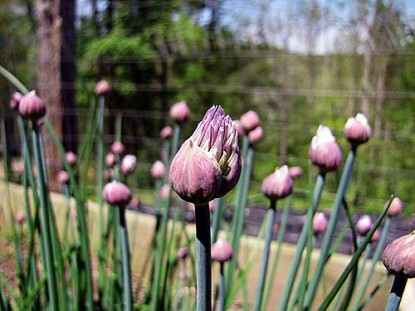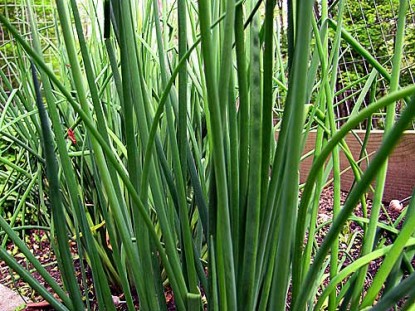As I start a series here on Farm Bell Recipes spotlighting herbs, one at a time, I decided to begin with chives as they are one of the first herbs to go nuts in the garden each spring. My chives popped up weeks ago and already tried to bloom. A neat idea suggested by several people was to cut off the pinkish-lavender blooms, place them in white vinegar for a few weeks, to produce a pinkish and garlicky vinegar for salads. Wickedgoodshari described her method this way: “I put fresh chive blossoms in a jar/pretty bottle of white vinegar (maybe 1/3 to 1/2 full) and put it in the window. The flowers bleach out, the vinegar turns pink and then smells and tastes garlicky. You can take out the flowers, but it looks pretty with them in the bottle.”

One idea leads to another, so that got me thinking about chive blossom jelly! (You would make it just like any flower jelly–see the basic recipe how-to here.) The blooms are edible, of course, so they could also simply be tossed on salads or used as decorative (and edible) garnishes for other dishes. Oh my! All the things you can do with chive blossoms! And we haven’t even gotten to the actual chives!

Chives (Allium schoenoprasum L.) belong to the same family as onions, leeks, and garlic–and ramps! As would be expected from a plant in the same family with onions, they have an onion flavor, though they are milder than onions. Garlic chives have a more garlicky flavor (and produce white blossoms). Chives are easy to grow and will come back year after year. When harvesting, chop them down to two or three inches. They will grow back in no time! Chives grow in clumps and can be propagated by dividing the clumps. They are hardy, and will even grow in the winter. You can also grow them inside on a windowsill. They impart the same health benefits as other plants in the Allium family, including reducing the risk of cancer.
Native to Europe and Asia, chives weren’t actively cultivated until the Middle Ages. The first documented use of chives come from the ancient Chinese, and Marco Polo–or the Romans–depending on the source–is credited with bringing chives to Europe. In any case, chives now grow wild all over the Northern Hemisphere, along with in practically every home garden as even the blackest-thumbed gardener would be sore-pressed to kill them!
When cooking with chives, if possible (depending on the recipe), add chives last and at the last minute to benefit from the full flavor, which is at its peak when raw.
To freeze chives, chop and place on a cookie sheet then put the sheet, uncovered, in the freezer. Once dry and frozen, transfer to a tightly-sealed container. They keep well in the freezer for six months or more. You can also dry in the dehydrator, though you will lose some flavor that way. Chives are best used fresh or stored frozen.
See all the blog posts in Herbs & Spices.
Do you have a recipe post or kitchen-related story to share on the Farm Bell blog? See Farm Bell Blog Submissions for information and to submit a post.
Want to subscribe to the Farm Bell blog? Go here.



GrannyTrace says:
I never realized how pretty they were.
Thanks for sharing.
Granny Trace
http://www.grannytracecsrapsandsquares.com
On May 7, 2011 at 8:47 am
brookdale says:
Thanks for sharing the chives info. I love the pretty purple flowers. They dry well to use in arrangements too.
I pot up a clump in the fall and bring it inside to use in the winter. They grow good on a sunny windowsill.
On May 7, 2011 at 8:56 am
Kacey~Kay says:
Timely. Some of my chives have blooms now. I think I might try the vinegar/chive thing…
On May 7, 2011 at 9:07 am
Cathy Jones (catray44) says:
I am going to try overwintering them in the window- how exciting! Did you make the chive jelly? If so, how was it?
On May 7, 2011 at 9:17 am
Suzanne McMinn says:
I haven’t made the chive jelly yet. =Somebody= who shall remain nameless was helping me out and chopped all the blossoms off. I’ll get ’em next time and make the jelly. I think it will be one of those jellies that are really good with cream cheese on crackers!
On May 7, 2011 at 3:57 pm
Jennifer M says:
Don’t forget that chives also help fight against heart desease, stroke and stomach distress. I love chives on potatoes and on my salads. Think I just might have to make a vinager.
On May 7, 2011 at 11:18 am
AnnieB says:
Chive blossoms are so pretty! They have a very strong onion flavor, though – much stronger than the leaves, so be careful when using them 🙂
On May 7, 2011 at 1:49 pm
Miss Nellie says:
Think chive vinegar is on my to do list from CITR, no I think I’ll just go do it now – never mind the list.
On May 7, 2011 at 3:51 pm
BeverlyC says:
OH MY!!! I’ve missed CITR!!! Great read on chives. LOVE ’em! Will be planting them for the 1st time this week…..garden is being tilled as I type 🙂
On May 7, 2011 at 6:32 pm
Ross says:
I have garlic chives and they are prolific seed producers. Should anyone desire seed I will gladly seed seed in autumn when it is mature. Unlike pink blossum chives garlic chives have flat leaves. My favorite use is with sauteed shrimp.
On May 7, 2011 at 9:46 pm
Leah's Mom says:
I’d love some seed!
On May 8, 2011 at 12:00 am
Ross says:
When the seed is ripe this fall I will make a post to that effect.
On May 8, 2011 at 10:28 pm
kuph8s2cook says:
I have twice, transplanted chives form my MIL’s garden in Colorado to my garden in TX. I’ve killed them both times. I’m not sure what I’m doing wrong.
Maybe it’s the soil. I’m going to try again in another spot in my garden come spring of 2012!
On November 8, 2011 at 3:24 pm